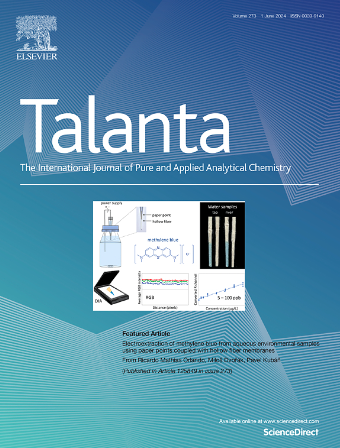Finger-actuated microfluidic chip integrated with visual immunoassay for ultrasensitive detection of PSA in whole blood
IF 5.6
1区 化学
Q1 CHEMISTRY, ANALYTICAL
引用次数: 0
Abstract
Cumbersome preprocessing and specialized manual operations in clinical blood samples remain a significant challenge for achieving high sensitivity and accurate quantification in point-of-care testing. In this paper, a finger-driven integrated microfluidic chip based on visualization of single nanoparticle scattering was proposed for the detection of prostate-specific antigen (PSA) in the whole blood. To control on-chip fluid, a finger-driven module based on a Tesla valve was designed to unidirectionally regulate fluid mixing and separation in the microchannel. In addition, a membrane separation unit was designed to efficiently separate blood cells and serum, reducing interference from blood cells in the detection process. For quantitative PSA concentration detection, a Multi-functional core-satellite magnetic probe was constructed by using the principle of complementary base pairing of ligands on the surface of gold nanoparticles and magnetic beads. In the presence of target PSA, the constructed core-satellite nanostructure was decomposed, producing a characteristic fluorescence signal and releasing gold nanoparticles with green scattering spots under dark-field microscopy. By correlating the concentration with the number of green scattering spots, cancer risk levels were displayed intuitively using a traffic light system. This biosensor achieves an ultra-low detection limit of 0.5 pg/mL for PSA. Due to the ultra-sensitive ability in detection, the monitoring of PSA concentrations for patients during treatment was also demonstrated. Compared with other methods, this proposed microfluidic assay technology has the advantages of small sample volume, minimal operation, high sensitivity and accuracy. Overall, this biosensor provides a new approach for cancer recurrence monitoring and early diagnosis.

求助全文
约1分钟内获得全文
求助全文
来源期刊

Talanta
化学-分析化学
CiteScore
12.30
自引率
4.90%
发文量
861
审稿时长
29 days
期刊介绍:
Talanta provides a forum for the publication of original research papers, short communications, and critical reviews in all branches of pure and applied analytical chemistry. Papers are evaluated based on established guidelines, including the fundamental nature of the study, scientific novelty, substantial improvement or advantage over existing technology or methods, and demonstrated analytical applicability. Original research papers on fundamental studies, and on novel sensor and instrumentation developments, are encouraged. Novel or improved applications in areas such as clinical and biological chemistry, environmental analysis, geochemistry, materials science and engineering, and analytical platforms for omics development are welcome.
Analytical performance of methods should be determined, including interference and matrix effects, and methods should be validated by comparison with a standard method, or analysis of a certified reference material. Simple spiking recoveries may not be sufficient. The developed method should especially comprise information on selectivity, sensitivity, detection limits, accuracy, and reliability. However, applying official validation or robustness studies to a routine method or technique does not necessarily constitute novelty. Proper statistical treatment of the data should be provided. Relevant literature should be cited, including related publications by the authors, and authors should discuss how their proposed methodology compares with previously reported methods.
 求助内容:
求助内容: 应助结果提醒方式:
应助结果提醒方式:


